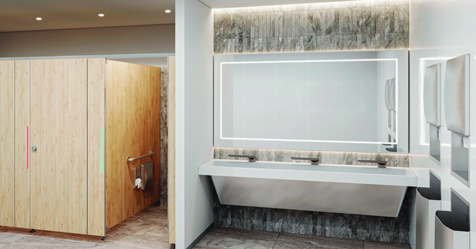Due to the current economic downturn, worker productivity in the professional cleaning industry is now more important than ever.
Of course, this issue has never been something the industry could afford to ignore — it”s just that other issues and trends have been getting quite a bit more attention during the past few years.
When looking for ways to improve worker productivity — which can be defined as a decrease in the amount of time spent performing specific cleaning duties, thereby cutting labor costs — there are two critical components: People management and cleaning procedures — products, systems and methods.
The most advanced, efficient and effective cleaning systems will not improve worker productivity if cleaning workers are ill-trained to use their equipment.
And even the most skilled and well-taught cleaning workers will likely fail, or at least not work up to their full potential, if the cleaning products, tools and equipment they use add time to the cleaning process instead of reducing it.
These facts are especially true of restroom cleaning.
No other regularly performed cleaning task requires as much time and attention as restroom maintenance.
It is historically one of the most labor-intensive cleaning chores; what”s more, as we in the industry well know, restrooms are also the most problematic area of a facility to maintain.
This is because without some proof that a surface is truly, hygienically clean, evaluating restroom cleaning and maintenance has always been extremely subjective.
The good news is that worker productivity, especially when it comes to restroom maintenance, can be enhanced significantly.
People and procedures are at the heart of both the problem and the solution.
It’s All About People
At the recent annual meeting of the Consumer Specialty Products Association, the manager of a major U.S. government facility discussed how he had “greened” his building and how it eventually earned Leadership in Energy and Environmental Design (LEED) certification as a result of his efforts.
This speaker also talked about the large disparity he sometimes experiences between what cleaning contractors promise in terms of worker training and what they actually do.
While many contractors “talk the talk” when it comes to ongoing training programs for their cleaning workers, in far too many cases, the presenter finds this training simply never takes place.
In fact, he even mentioned that in some situations, he and his staff found themselves training cleaning workers on how to maintain certain areas of their facility or use certain products.
Situations like this are actually at the heart of poor worker productivity.
Workers turn to managers for direction — but in some cases that direction is simply not there.
This fact was born out in a study conducted by Proudfoot Consulting, which is an operations-management company that performs a variety of studies regarding worker productivity issues.
This 2006 study asked U.S. executives to rank leading barriers to worker productivity in their organizations.
Three of the top obstacles mentioned were:
- Poor management of people
- Poor leadership in terms of managing and training workers and leading change
- Poor communication between managers and workers.
According to this same report, cleaning contractors looking to improve worker productivity and create a high-performance staff can take a number of steps to accomplish this goal, including:
- Making productivity a strategic initiative. Improving worker productivity needs to be one of an organization”s key “top-down” goals, and this message should be communicated frequently to all workers.
- Aiming high. Improvement goals should be ambitious and once a productivity goal has been attained, managers and workers should look for additional steps that can be taken.
- Training people on the job. As valuable as classroom training can be, actually coaching people on the job is critical to enhancing their performance.
- Communicating clearly. Workers need to know why things have to change in order to improve productivity and encourage feedback. Further success and accomplishment must be communicated immediately to demonstrate positive results.
- Measuring performance. Every improvement initiative must be measureable and measured. For restroom cleaning, this not only involves analyzing whether restrooms are being cleaned faster, but also if they are being cleaned more thoroughly and hygienically.
Cleaning Procedures
Finding ways to use fewer cleaning products, chemicals and methods makes cleaning faster and helps improve worker productivity.
This is especially true of restroom maintenance, in which a variety of different cleaning products and tools — cloths, disinfectants, chemicals and powders, mops and buckets, window cleaners, etc. — are typically used to clean a number of different surfaces, including fixtures, partitions, countertops, floors, glass, mirrors and metals.
Cleaning professionals should always try to turn to chemicals and supplies that can multitask.
For instance, using one product that can clean both fixtures and mirrors saves time, helps eliminate mistakes and means fewer items that must be loaded onto cleaning carts — all of which can help improve worker productivity.
Taking this a step further, using one cleaning method or procedure that can clean all of the various surfaces found in restrooms would eliminate even more tools and equipment and likely improve worker productivity even further.
This is why many facilities have adopted what ISSA refers to as spray-and-vac cleaning.
This method involves using machines that pressurize water and metered cleaning solution, and then apply it to soiled, contaminated surfaces.
The area being cleaned is then rinsed, blasting loose pollutants from surfaces, followed by vacuuming the same areas to remove excess liquids, soils and contaminants.
Prove It’s Clean
Even when focusing on worker productivity, we must never forget the chief purpose of our industry, as well as that of the individual cleaning worker — protecting the health and safety of building occupants.
This issue is especially pertinent when it comes to restroom maintenance.
Cleaning professionals can turn to adenosine triphosphate (ATP) rapid-monitoring systems to test cleaning effectiveness and help determine that surfaces are hygienically cleaned.
Because of the cost savings associated with improved worker productivity, we likely will see our industry and most all industries look for additional ways to accomplish more in less time.
A recent article in The New York Times reported that the economic recession “is forcing a return to a culture of thrift that many economists say could last well beyond the recovery.”
Although this focus never entirely disappeared in the cleaning industry, increased emphasis on improving worker productivity is likely to last far into the future.



